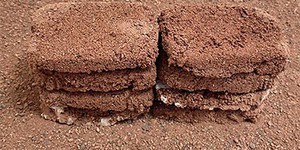Others Like “Materials for Sound Barriers” (top 20 results)
|
Try different wind turbine/propeller (chord length, pitch) designs by making models from balsa wood. Connect the spinning axle to a DC motor and measure the voltage produced across a resistor to measure power output. Use fan as wind source. (Judge, 2004)
Read more
For a colony of humans to survive and thrive on Mars, they will need to make the most of what is available on Mars. We know from prior space missions what the Martian ground cover looks like. In this project, you will see if this ground cover can be transformed into strong construction material.
The first requirement for construction material is that it is strong so it does not collapse under its own weight. Because the mass of Mars is about 10 times less than the mass of Earth, its…
Read more
This project can apply to soccer, hockey, baseball and many other sports. What is the effect of stopping the kick/shot/swing at the moment of impact vs. following through? Think of a way to measure the outcome in each case, and explain your results. (idea from Gardner, 2000, 83-85; for more information with regard to specific sports, see: Barr, 1990, 12-14; Gay, 2004, 142-144; Adair, 2002, 30.)
Read more
You've seen that a magnet's attractive force can cause a small object (like a paper clip) to "jump" to the magnet. So a magnetic field can act through the air, but what about other materials? Here's an experiment you can do to find out. You'll need a strong bar magnet, a stack of books, a paper clip, some thread and tape. Place the bar magnet underneath the top book in your stack, so that it sticks out. Tie a piece of thread (as long as the stack of books is high) to a paper clip. You…
Read more
An electric current produces a magnetic field. You can take advantage of this fact to make a simple apparatus to test the electrical conductivity of various materials, including both solids and liquids. The detector consists of a coil of wire, with a magnetic compass inside it. You connect one end of the coil to a D-cell battery. The other end of the coil is connected to whatever material you are testing, and the material, in turn, is connected to the other end of the D-cell. In other…
Read more
Here's a fun project idea to learn about compression forces. For this experiment you'll need some empty toilet paper tubes, masking tape, sand (or table salt), pebbles (or marbles), a funnel, a cardboard box, and a sturdy chair to help you balance while testing the column. Seal one end of the tube with masking tape. Use the funnel to fill the tube with sand (or salt). Seal the other end with tape. Place the tube on end inside the paper box. Place the chair with its back to the box and hold…
Read more
Aerodynamics and Hockey: Does the Force of Drag Have an Effect on the Distance the Puck Will Travel?
Think of a way to launch the puck with a reproducible force, and examine the effect of launching the puck in different orientations on the distance it travels. For more information on the physics, see Haché, 2002.
Read more
Have you ever bitten into a slice of bread only to find that it no longer seems fresh? Instead, it has the firm, undesirable texture that comes about when the bread is going stale. Chemically, what happens during the staling process? Can it be reversed (at least temporarily)? Do some background research to answer these questions and then apply those answers to one (or more) of the following experiments to find the optimal state to keep your bread fresh.
Experiment 1: What Temperature Keeps…
Read more
Using just a single sheet of paper (8.5 x 11 inches) and up to five paper clips, can you build a bridge that will span 20 cm and support the weight of 100 pennies? The area beneath the span must be free (so that boats can pass beneath it). To test your bridge, place two books 20 cm apart, and set the bridge on the books, spanning the gap. Do not fasten the bridge to the book (nor to any other support). Does your bridge hold as much weight as you expected it would? If your bridge fails…
Read more
What do a guitar, a piano, a harp and a violin have in common? Turns out a couple of things, including a soundboard. All stringed instruments use a soundboard to amplify (greatly increase) the volume of the sound coming from vibrations of the strings. The soundboard is positioned so that it gathers the sound vibrations coming from the strings and then retransmits them at an even greater volume when it begins to vibrate. Soundboards are common in the world of musical instruments, but they can…
Read more
|
Explore Our Science Videos
Draw with a Pantograph - STEM Activity
Build A Vortex Cannon!
What Do Enzymes in Pineapple Juice Do to Milk?






